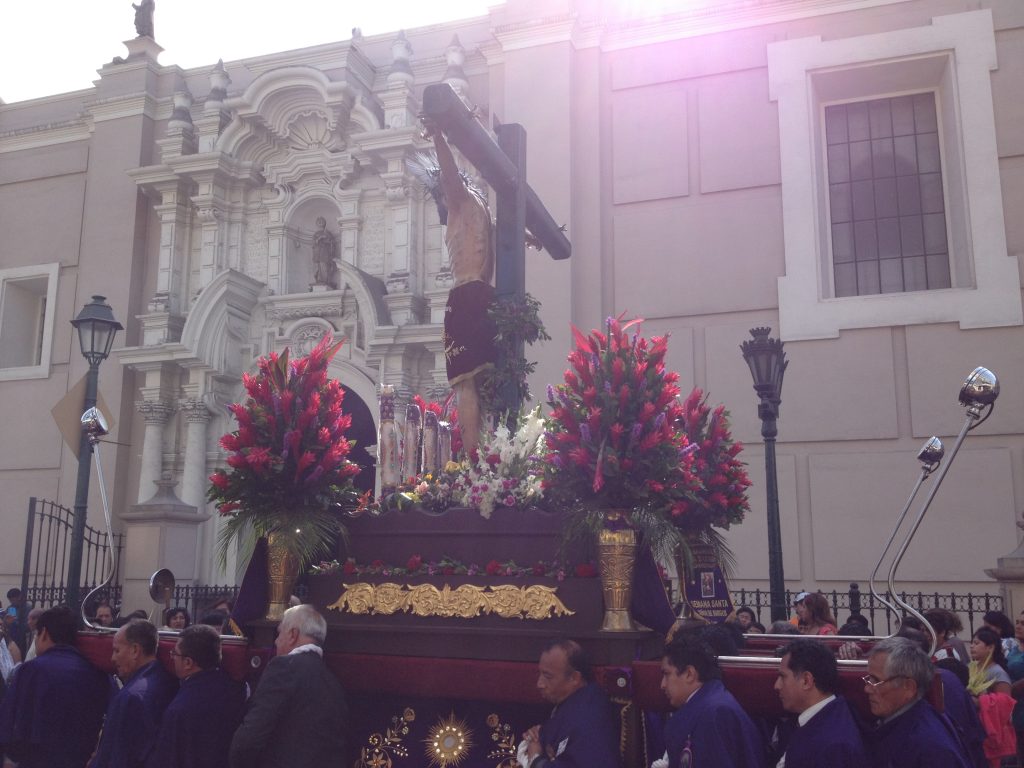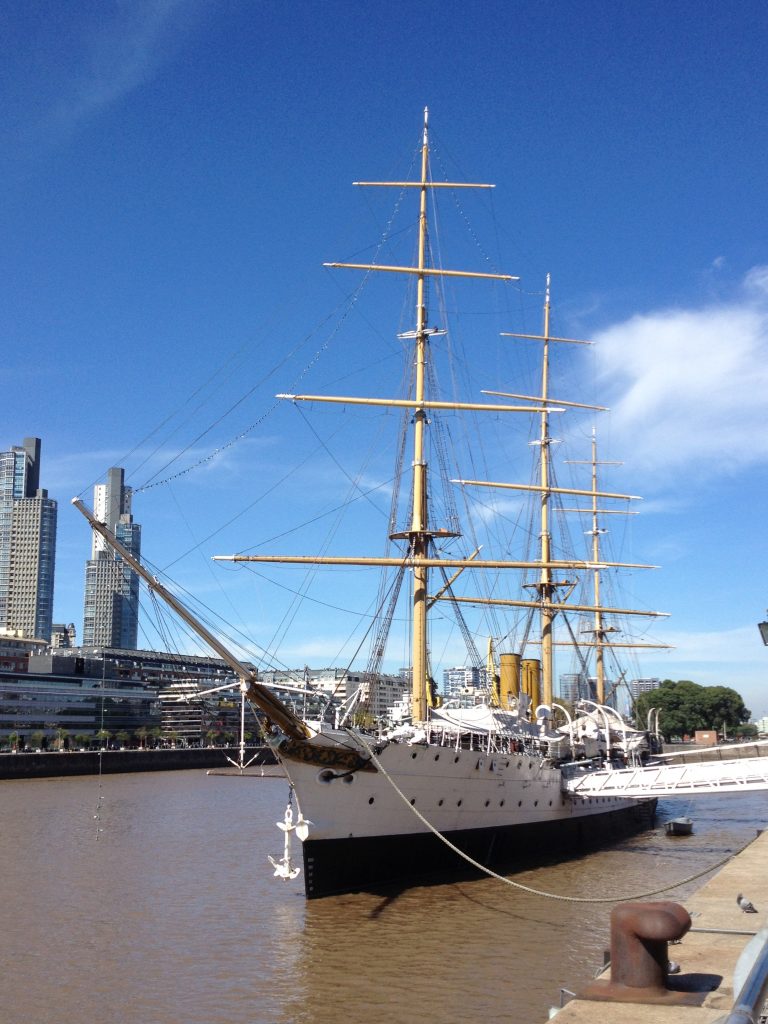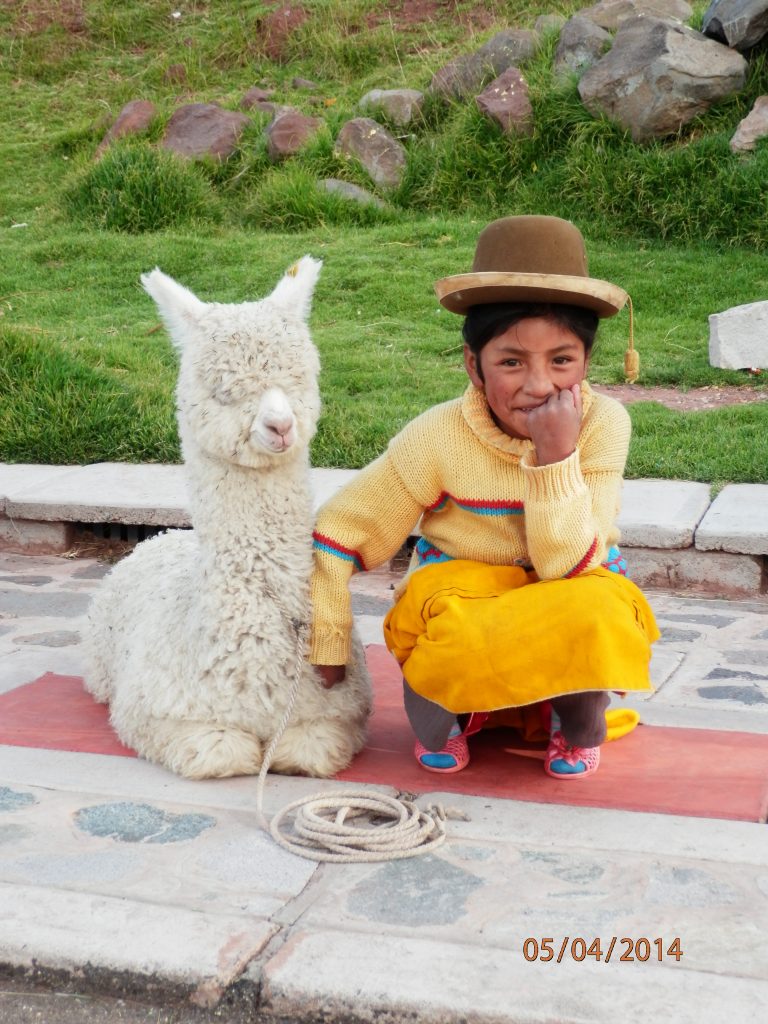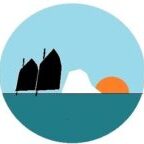CAPITALS (21 APRIL 2014)
Lima. We rolled in to the terminal in the bus from Nasca in the early afternoon, and Franco, who had identified himself in his emails as “staff” of the hostel we had booked to stay in, was there to meet us. He had soon flagged down a taxi (one of the slightly decrepit, cheap ones, not a shiny, undented expensive “tourist” taxi), and in we piled with our bags. It was cozy.
We drove from the bus station into the centre of the city, with many old colonial buildings shabbily lining the streets. The traffic was what I would term “interesting” – one of my favourite terms, in this case meaning something between “frightening” and “downright deadly”. Stu and I took turns at being side airbags as our driver squeezed through unlikely gaps and diced with buses in both directions whilst, like the rest of the traffic, completely ignoring any conventional traffic rules which may have made it to the Peruvian statute books. Driving in Lima is like driving in India, but without the strict pecking order. In India, at least you know your place – it runs like this (in increasing order of priority): motorbikes; tuk-tuks; cars; lorries; buses. No such orderliness in Peru. It is every man, woman and child for themselves. Anyway, I digress slightly. We went through the centre of the city, and out the other side (bear in mind that our hostel was called the “Downtown Backpackers Lima”). The buildings lost their impressiveness and colonial order, returning to the typical concrete-and-brick boxes of unfinished appearance. We turned from sketchy-looking road into even-sketchier-looking road, until we reached a residential street in what was once a shanty-town which has come of age and turned into a proper district called Rimac, and Franco indicated that we had arrived. He had kept up a fairly constant commentary in his good but idiosyncratic English, and pointed out that we were only about 20 minutes’ walk from the historic centre of the city. It felt like a hundred miles. He showed us past his neighbours who were having a barbecue on the pavement and in through the hallway, up two flights of stairs to the “hostel”. I use inverted commas only because we had become used to the sort of accomodation with dormitories and lots of hairy, rucksack-toting young Germans (male and female), slightly punky graffiti designs artistically painted on the walls and all that sort of funky backpacker jazz. This was somebody’s flat. In the living room, a corner cupboard had been designated “Reception”, with a handwritten, A4 sign indicating that this was the case blu-tacked above the door, other similar signs indicating the bathroom, kitchen, and most amusingly, the “Bar” – which was the sort of glass-fronted drinks cabinet you would find in any home. After registering, we went upstairs to our room, next door to which was another bathroom, albeit this one had no roof and you could not shut the door from the inside (or do I mean outside?) as you thereby lock yourself out of the flat. All of this, and Franco’s continuing commentary, was again idiosyncratic, but mostly endearing, and we both warmed to Franco’s enthusiasm. In fact, Franco is probably reading this, as we became Facebook friends and therefore he now has access to my inner thoughts. If you are, Franco, then I really loved your place because it was so different from everywhere else we stayed!
After we had got settled in and relaxed for a while, we took Franco up on his kind offer to show us the neighbourhood. We walked down to the commercial centre which was full of everything you would expect of a local shopping street: bakeries, groceries, a supermarket, hairdressers, plenty of eateries. Shambolic the neighbourhood may have appeared, but it had obviously tried hard to gain respectability, and at no time walking around this area did we feel unsafe.
So, we went and found a bank machine, and then went for a Chinese meal. This is something we had joked about up until now, but Franco pointed out that there was a substantial Chinese community in Peru, dating back to the 19th and early 20th centuries, and that the community had developed their own variations on Chinese food, so we thought we’d give it a go. For less than five pounds each, we had enormous plates of food, piled about 4 inches high, and a beer, and neither of us could finish our food.
As it was now knocking on for about 7 o’clock, we decided to head home and watch a DVD. Having got the TV and DVD player on our floor to a functioning state, we then had the task of selecting whichever of the DVDs (knocked-off copies) actually had an English soundtrack. We went through Spanish, German and Russian before settling on “A Few Good Men”, which spoke the right language with Spanish subtitles, and a substantial delay between the actual words and the actors’ lip movements. Hey ho: you can’t expect everything in Peru!

The following day was sightseeing day in Lima, and we walked the route recommended by Franco into the centre, passing quite an impressive park containing 12 marble statues, and an equally impressive wall bearing a sign “this wall is about to collapse – walk on the other side of the road”. After crossing the river Rimac, we soon arrived on Plaza de Armas, where the cathedral, archbishop’s palace and government palace (formerly the Viceroy’s palace in colonial times) make for a very impressive square. The whole city centre was teeming with tourists and locals alike, it being Palm Sunday, and therefore the beginning of la Semana Santa (Holy Week), which for many is a holiday. We spent the day walking round (in quite oppressive heat), seeing churches, convents, monasteries, the old city walls (or what is left of them) and a couple of Palm Sunday processions of the type which involve a team of old men in suits marching in a state of near-collapse under the weight of a massive platform bearing a statue of the Christ, or the Virgin, or some saint or another, whilst being egged on by incense-waving women in the front (walking backwards) and a band shambling along behind, their sheet music clothes-pegged the the shirt-backs of the musician in front (one trombonist had not gone for this technique, and it was quite amusing watching him trying to play and turn his page at the same time).
It being a hot afternoon, we settled down at about 3 o’clock at a cafe just off the Plaza de Armas and ordered “frozen Lemonade” – lemonade with crushed ice. Unfortunately on trying the first couple of sips, I discovered that they had put the ice in the blender without first removing the polythene blister pack in which it was frozen, the result being that the drink was spiked with small shards of plastic, which didn’t go down too well (literally). Nor did the fact that the waiter offered no apology, so we left without paying, went to the cafe opposite and ordered exactly the same. Unfortunately we didn’t realise until too late that they were evidently both owned by the same people, which diluted our feeling of satisfaction somewhat, but the lemonade and the Dulce de Leche pancakes were very nice nonetheless.
Having had our fill, and then a coffee, it was time to head back to the flat before it got dark, with the promise of a local speciality for our evening meal, cooked by Franco’s family. We took a slightly different, more direct route, back to the flat. This took us through slightly more sketchy streets than we perhaps might have liked, with some genuinely shanty-ish buildings, but we made it safely back to the commercial area, where I decided to get a haircut. I have always thought that getting a haircut abroad is one of travelling’s great adventures, and I chose a small shed on the pavement which had a bored-looking woman working in it (just outside a possibly more reputable hair-cutting establishment, but so what). I managed to get across in a mixture of Spanish and sign language which parts of my head I wished to keep, and she set to it. It was when she got to the bit where out comes the cutthroat razor that my first-world inhibitions kicked in and I sat there very still, thinking to myself “don’t cut me, don’t cut me, pleeeaaase don’t cut me”, whilst Stu looked on, amused (when not making sure he wasn’t going to be robbed, anyway). I thought that only someone with long hair and a beard can sit there looking so pleased with himself!
After the hairdresser had left my ears attached to my head and given the shaved areas a reassuring rub with a bit of alcohol-soaked cotton wool, we went back to the flat to await a dinner of Ceviche (traditional Peruvian raw fish, “cooked” in a mixture of lemon and lime juice, herbs and incredibly hot chillis) and a Pisco based libation. This had been prepared by Franco’s father, and was utterly delicious, although the chillis left us with numb lips!
After a reasonably good night’s sleep (standfast the out of sync cockerels and dogs barking – in fact in the morning the district was pretty much under an acoustic blanket of cockerel crows), we got a 7 o’clock taxi to the airport (again, airbag duty as the driver attempted to squeeze his taxi through time and space whilst buses were determined to use us as a doormat), being dropped at the tradesman’s entrance, as the non-shiny variety of taxi obviously does not get licences to trade within the airport boundaries. In due course, after a breakfast in one of the airport cafes where the cafetiere had to be used twice to enable both of us to have “French Press” coffee, we got on our flight to Buenos Aires.
Some hours and a couple of movies later, we landed, surprisingly getting both our rucksacks back again, and hopped in a very shiny taxi, in very orderly traffic, to head into town to find our hostel. This turned out to be in the very centre of the city and would have been ideal for sightseeing, had we had any time for such frivolous activities. As it was, after settling in and getting a shower in our very funky “Rock Hostel” – we were in the “Doors” room, we wandered to a traditional Argentine restaurant which was recommended as being not expensive by the hostel receptionist. She had lied, but we had a very good steak dinner anyway, and then Stu was defeated by his “Don Pedro” dessert, which turned out to be very akin to double strength Baileys with a lump of ice cream in it. I walked and Stu wove his way back to the hostel, where we then lay listening to the loud music and raucous conversation from the party being held in reception until about 0230. Or I did, anyway, Stu choosing to do his usual Rip van Winkle impression and managing to fall asleep the minute his head hit the pillow, and remaining in that state until the alarm went in the morning. The only advantage of the noise from the party in the corridor was that it did serve to drown out the traffic in the square outside.
We had a relatively slow start in the morning, knowing we didn’t have to be at the ferry terminal until 1300 for our catamaran to Uruguay. We set off towards the docks to spend some time at least doing some minor sightseeing, and soon came across the Sarmiento, the former Argentine Navy sail training ship (and predecessor to the ARA Libertad, in which I spent 3 months during my time in the RN). Conveniently there was a cafe opposite at which we could spend our last Ikkies on a filled croissant (tiny) and coffee. It was whilst sitting there, soaking up the sunshine and pleasant atmosphere, that I looked again at our ferry tickets. We were booked on the 0900 ferry that morning. Bugger. We forgot any ideas we had about lingering and maybe looking at the Sarmiento, and legged it to the road to get a taxi to the ferry terminal. We managed to procure tickets at over twice the price of the original internet specials for the 1400, and went through immigration in good time to catch the boat, whilst I kicked myself thoroughly for not checking the tickets beforehand.

The ferry took us across the Plate estuary to the Uruguayan town of Colonia (one hour), which by all accounts is quite pleasant, but we hopped on the bus straight away to Montevideo (2 hours or so), and enjoyed the trip through the Uruguayan countryside to the capital (very flat, very green). At the bus station we got yet another taxi (in the queue of shiny Toyotas and VWs, we got the clapped-out Fiat Uno – possibly imported specially from Peru) which rattled through the streets of Montevideo to yet another hostel, this one slightly funky and full of Brazilians. We followed the now-familiar pattern of settling in, having a quick stroll, then going to forage for dinner – this time typically Uruguayan, a mixed Parilla for two. I was slightly put off by the inclusion of kidneys and chitterlings (for those under the age of 40, these are the small intestine – eeeuuurgh!), but Stu was quite happy to hoover through those bits of nastiness whilst I nabbed his nice bit of chicken and took the bigger portion of blood sausage. How is it my stomach turns at the mere thought of eating digestive organs, but I’m quite happy to guzzle congealed blood and even, as long as I don’t think too hard about the ingredients, Haggis? One of life’s great mysteries – but I shall live an entirely happy life without having the privilege of eating something else’s internal bits and pieces. Stu, however, has no such reservations, and seems to be quite happy to guzzle any tubes, filters or other rubbery bits – the more unpleasant their function, the better, it seems.
Anyway, after the mostly delicious meal (pudding for me was a divine quartet of chocolate heaven, including an ice-cream scoop sized lump of dark chocolate cookie dough), we headed back for a beer and wifi at the hostel before hitting the hay (for a much better night’s sleep – apart from the Brazilian girls nattering in the courtyard outside both late at night and early in the morning. Stu slept through it all, of course).
In the morning, having decided that Montevideo is possibly the most unremarkable capital city in the world, off we went to the bus station again, and bought tickets for the first available bus to Punta del Este. Driving to this “Monaco of South America”, you pass some of the most varied architecture you can imagine. From sprawling, American-style single storey mansions, past thatched cottages, art-deco edifices, Chinese pagodas, and back to mega-bungalows again. This variety leads one to think that planning authorities in Uruguay are not too fussy about the vernacular.
After a couple of hours we pulled into Punta del Este’s bus station, where we had another filled croissant lunch at the surprisingly good cafe, and Stu bought his tickets for his return bus to Montevideo airport in preparation for our parting, then we hopped in a taxi (quite shiny) to our hostel. This one was in la Barra, which was a goodly ride out of town, and turned out to be a low-key, low-rise, surfers’ town, and very pleasant. The hostel was tucked back from the main street, and was a cut above our norm, as I had insisted on a guaranteed good night’s sleep prior to returning to the ship. It seemed to be constructed from portacabins but was newly and very well fitted out, and the room was big (actually 4-bed, but as we had booked a twin the bunk beds were left unoccupied), and had an en-suite with a very powerful shower. Wooden flooring, his and hers basins and a sliding patio door into the garden (unfortunately mozzie-infested); wifi, a pleasant lounge and kitchen, a good breakfast and even a swimming pool completed the ensemble. All in all, of all the places we stayed, I would definitely return to that one if I were in the neighbourhood.
Anyway, again the usual routine: beer, stroll (I had a swim in the sea, my first all leave, whilst Stu rockpooled and got excited about seaweed), and then food. The variety of eateries was not great, the whole town having a closed-up, end of season air, but we found a nice bar which did burgers and a very sticky, sickly, chocolatey pudding, along with more beer. We waddled back for the last night of our travels, and I slept like a log for over twelve hours, but Stu got bored and wouldn’t let me lie in beyond 0830. Meanie.
After a marvellous relaxed breakfast and long chat with a Norwegian couple on a 7-month period of travelling, we got in an extremely shiny taxi (driver wearing jacket and tie) and headed back to Punta and the Lord Nelson. After finally moving into my cabin once my opposite number had got round to moving out, we ate on board but went out for a final beer together before Stu headed home. Needless to say, after a total of 5 1/2 months in each others’ company, it was a wrench to say goodbye the next morning, but life goes on… and I hope this will not be the last adventure that we share together.

Photo – Stu Sheldon
